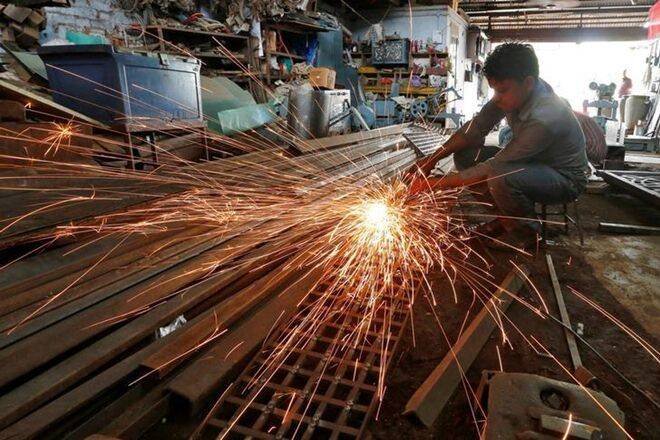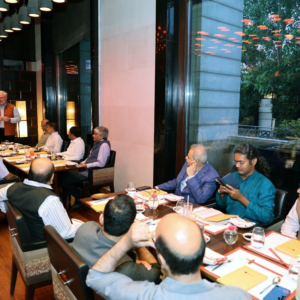Abstract:
The Modi Government, if one includes its first term since 2014, is on the verge of celebrating its seventh year in office. During its entire tenure since its historic mandate in 2014, the government has taken important policy measures to meet its core social agenda and fulfil poll promises. On the economic front; however, its performance has been a mixed bag, partly due to systemic flaws of the Indian economy, which need to be overcome. Implementation of the GST is one of the biggest economic reforms this Government has taken. Additional reform measures which have now been undertaken need to be supplemented by a concerted push towards unlocking India’s manufacturing potential, which will be its gateway to a high growth trajectory. This article highlights the significant achievements of the Modi Government in making India a major manufacturing hub as also draws attention to the sectors which need greater attention. The ongoing agenda of ‘Make in India’ needs a booster shot of policy measures and a clear vision.
One of the biggest problems plaguing Indian manufacturing has been an extraordinary, almost excessive, push towards the services sector. The growth in services exports has been so rapid – much higher than some of the other Asian economies—which now account for 35 percent of total exports – it almost made it unnecessary for policymakers to focus on manufacturing. This has been a major impediment to manufacturing not getting its due share in policy making, almost robbing it of its potential and importance. Not enough investments come into this space, thus not enough policy intervention takes place, reinforcing the trend of suboptimal investment, making it a vicious cycle. The present government has tried to undo some of this, with a slew of measures aimed to make India an attractive investment destination. Some of them, including the quantum jump in India’s ranking in World Bank’s Ease of Doing Business ratings are notable achievements. From a dismal 142 in 2014 when PM Modi took office to an impressive 63rd position in 2020, India has climbed a remarkable 79 points[i] in a short span of time. World Bank ranks countries on a number of parameters to highlight how easy/tough it is to start a business.
The most significant reforms undertaken by the government in its second term have been on the contentious issue of labour reforms and lowering of tax rates for companies to set up a manufacturing base in India. Changes in labour laws, long considered to be one of the most stifling aspects of India’s maze of rules that govern industry, were long overdue. It is heartening to see the PM unafraid of displaying his hand to back tough, even politically unpopular, reforms. The new labour code, which was originally meant to be implemented from 1st of April 2021, has been pushed ahead due to a delay on the part of States. Irrespective of when it is rolled out, the new labour laws will allow greater flexibility to employers in laying off workers. Among other changes, the threshold limit for firing workers without government approval has been hiked three times (from a company having 100 workers to one employing 300 workers)[ii]. Earlier labour laws – which were based on the size of the enterprise – incentivised factories to remain small, thereby stunting growth potential. Equally important is the expansive scope of the new labour code. Unlike the earlier laws; gig and platform workers, food and grocery delivery, content & media, ride sharing services and e-marketplace is covered, ensuring workers in these sectors are brought under the ambit of regulation. Since labour is an issue that falls in the concurrent list, allowing both Centre and States to have an equal say, the implementation of these laws will decide their success. Needless to say, states that will adapt to these changes faster will be viewed more positively by investors[iii].
Apart from labour laws, what stands out in the government’s big bang reform agenda is the slashing of the corporate tax rate in 2019, to make Indian rates competitive with other Asian destinations. On 20 September 2019, less than four months into the Modi government’s second term, in a bold and surprising move, the government cut corporate taxes. Much before the pandemic struck in 2020, Indian economy had slowed down considerably. As the slowdown led to a clamour for ‘out-of-the-box’ measures, Finance Minister Sitharaman cut corporate taxes from 30 percent to 22 percent for domestic companies[iv]. This was the biggest tax cut in 28 years. To boost manufacturing and invite foreign investments, the FM lowered tax rates even further. From the earlier 25 per cent tax slab, new companies incorporated on or after October 1, 2019 which invested in manufacturing, were to be taxed at 15 per cent. Taking into account surcharge and cess, the effective tax rate for new companies stood at 17 per cent[v]. Post the rate cut, Indian tax slabs were in line with Asian peers. Hong Kong – mired with its own set of far bigger problems – has the lowest corporate tax rate of 16.5 per cent. Singapore has a 17 per cent rate, while both Thailand and Vietnam levy 20 per cent tax on companies.
The third and most compelling reform undertaken by the present dispensation has been the demonstration of its desire to pare losses of sick Public Sector Undertakings (PSU) and to exit government-backed ventures that are eating away precious state resources[vi]. Unprofitable PSUs – which are money guzzlers – have been a major bone of contention for successive governments, which continued to put good money behind bad money. PM Modi’s Government – which has enough political capital – has shown intent to divest stake or to completely privatise. The decision to privatise PSUs and stay invested only in a few strategic sectors is welcome, since state machinery is highly inefficient and corrupt. Though, selling entities like Air India sounds easier said than done (due to failure of multiple efforts), a clear intent to do so indicates a more welcoming attitude towards business in general. This marks a departure from the Prime Minister’s earlier position of being wary of being perceived to be ‘too business friendly’. The decisive shift began after the PM termed businesses as wealth creators in his Independence Day speech[vii].
But the question to ask is, despite such important decisions, why has India not been able to substantially move the needle on manufacturing? Despite a sharp jump in India’s rankings – which signify the growing ease with which business is conducted – why are foreign investors not making a beeline to invest? Easier labour laws should pave the way for big ticket investments, but what is stopping the same to materialise? The answer to all these questions lies in creating a favourable investment climate which is a combination of several inter-related factors. For instance, simplification of labour laws is a very important step towards creating a viable ecosystem, since it reduces compliance burden on companies. But flexibility in hiring and firing is, obviously, not enough to improve the anaemic growth in Indian manufacturing. Likewise, after the 2019 corporate tax cut; Japan, Malaysia, South Korea and Indonesia now have higher rates but that has not translated into a quantum jump in India’s investments vis-à-vis these countries.
Clearly, more needs to be done.
It is now a well acknowledged fact that no matter how rapid the growth rates may be in the services sector, it cannot keep pace with the number of new entrants in India’s work force. More so, since in India, the services sector contributes nearly 50 percent to the GDP, but only 35 percent to jobs. This is lower than the average of other countries where services sector contributes equally to GDP and job creation. Given India’s demographics, management consultancy firm McKinsey has predicted that in the decade 2020-2030, India will need to create 90 million new non-agricultural jobs. This is needed to absorb the 60 million new entrants joining the labour force and another 30 million for those who will move out of the less productive farm sector to industry[viii]. This kind of job creation is possible only through a vibrant manufacturing sector. The services sector, can at best, play only a supporting role to catapult India into the next league of economic superiority.
However, the manufacturing sector will also need to undergo a paradigm shift to cater to the socio-economic needs of India, which are a derivative of its high population and favourable demographics. At present, manufacturing contributes 15 per cent to India’s GDP, has a 16 percent share in the Indian economy, but just 11 percent in job creation. From fiscal year 2006 to fiscal year 2012, India’s manufacturing-sector GDP grew by an average of 9.5 per cent per year. However, due to the overhang of policy paralysis, scams and other factors, this slowed to 7.4 percent during the next six years – from 2012 to 2018.
In fiscal year 2020, manufacturing generated 17.4 per cent of India’s GDP, little more than the 15.3 per cent it had contributed in 2000. (By comparison, Vietnam’s manufacturing sector more than doubled its share of GDP during the same interval.) The ‘Make In India’ program – which was launched in September 2014 with much fanfare – had envisaged share of manufacturing to rise to 25 percent by 2022. Though ambitious from the very beginning, the program looked almost unachievable even prior to the pandemic due to the economy’s slowing growth in FY19 and FY20.
Post the outbreak of the pandemic, there has been a fresh focus towards manufacturing, led by the Prime Minister’s clarion call in May 2020 for ‘Atmanirbhar Bharat’.[ix]Since then, there has been a renewed effort to boost Indian manufacturing capabilities. The Production Linked Incentive (PLI) scheme—which identified 13 key sectors in January 2021—is a measure that can contribute significantly to India’s aspirations to be a manufacturing hub. Under this scheme, the government’s commitment will be Rs 1.97 lakh crore spread over five years, starting from FY 22. As the name indicates, the scheme proposes to provide incentives on incremental sales for a five-year period, which could be from 4-6 percent. Besides providing a fresh impetus to manufacturing, it will spur growth in exports – the one area which has been a disappointment for most of the seven years. (In 2014, the Modi Govt had set a target of Indian exports forming 5 per cent of world exports. However, seven years on, Indian exports continue to be at the same level- hovering in the 1.6-1.7 percent range, not even touching the 2 per cent mark.)
From 1April 2021, the PLI scheme for white goods will be rolled out after the expenditure finance committee cleared the proposal of Department for Promotion of Industry and Internal Trade (DPIIT) for investing in AC and LED segments. This would entail an investment of Rs 6,238 crore by the government. DPIIT has estimated the scheme would lead to additional exports of Rs 64,000 crore, and an additional GST collection of Rs.38,000 crore over a five-year period[x]. This segment can witness global players making sizeable investments.
The mobile handset manufacturing has been one of the few success stories in Make-in-India. From two units in 2014, the segment witnessed 200 units being set up, with production increasing from 60 million to 290 million. The value of handset production increased from USD 3 billion to USD 30 billion, all along catering to the domestic market. The next phase of growth will require the mobile handset cluster to become globally competitive and capture more than just the domestic Indian market. In the process, it will also test the efficacy of the PLI scheme – which skeptics say may not realise its stated objective due to the stiff targets for eligibility of incentives.
Beyond PLI, the solution to fixing India’s manufacturing woes requires action on five fronts – providing better infrastructure, creating efficient and predictable regulation, developing customer and supplier linkages, ensuring access to credit and solving the biggest conundrum of land acquisition.
Infrastructure bottlenecks are being addressed by the Government, but a combination of port connectivity and creating world-class manufacturing zones is the need of the hour. Seven out of the ten biggest ports in the world are in China; including the biggest – which is the Shanghai port. It is time Indian ports are upgraded on a war-footing. Though China’s economic model – with its focus on heavily subsidised state-owned enterprises and lack of any individual liberty – is incomparable with democracies, there are important lessons from its economic success. China opened six economic zones in 1979, followed by export processing zones across its coastal cities. As the largest recipient of foreign direct investment among developing nations (over 40 per cent), China saw total FDI inflows of USD 128.1 billion between 1979 and 1995. The distribution of this FDI highlights the role integrated infrastructure development (port linkages, better road/rail connectivity for cargo) plays in the growth of any economy. The coastal areas accounted for over 90% of all FDI China received during this period. Among coastal regions, Guangdong, Fujian, Shanghai and Jiangsu attracted substantial amounts of FDI, with Guangdong topping the list. About 60 % of the total FDI in the first decade of China’s SEZ policy flowed into Guangdong[xi]. This indicates how important it is to have large manufacturing clusters with back-end linkages. The corrupt, inefficient SEZ policy under the UPA-era needs to be replaced by an integrated plan to create top-end manufacturing zones with world-class infrastructure.
Creation of large manufacturing zones would also solve another issue that plagues this sector – which is of size, or the lack of it. Indian manufacturing landscape is dominated by ‘dwarfs’ or companies that should have scaled up but did not. Despite dwarfs making up almost half of organised manufacturing, their contribution in employment is a meagre 14 per cent and in value added is just 8 per cent. So, to be globally competitive and to provide jobs, Indian factories need to be scalable – which will be achieved through a combination of factors – technological evolution, better skills and access to credit on easier terms. In the past 13 years, India’s manufacturing-sector share of employment has risen by just one percentage point, as against a five-point increase for the services sector[xii]. This anomaly can be addressed only after addressing the dwarf problem.
Defence manufacturing – where government allowed FDI upto 74 percent via the automatic route in September 2020 – could be the next big growth frontier for India[xiii]. India imports about 65 percent of its arms needs and is hardly a global exporter (0.2percent as per SIPRI). Technology transfer via joint ventures with global companies, identifying goods that are in ‘negative list’ and India’s own growing security needs will act as the real catalyst to growth in this sector.[xiv]
India’s path to manufacturing should take two complimentary routes – one, driven by cost factors where it will have to compete with other low-cost destinations like Bangladesh or Sri Lanka in low-end goods, and two, based on innovation and R&D. What India lacks in terms of global supply chain linkages and economies of scale, it can make up by leveraging its strengths as an IT superpower. By developing niche areas of industrial research, domain expertise in industrial innovation can be created. This can be achieved through close collaborations with German, American, Swedish, Swiss and Japanese industries. These are countries that have been rated at the top of World Economic Forum’s global competitiveness index. With the help of tie-ups and sector-specific approach, India can identify its distinct edge and superiority in industrial innovation. This will be a key driver of future growth.
The Modi government needs to push the pedal on manufacturing since it is not just about economics but also about geo-economics and geo-politics. China’s strength in world affairs is due to its economic heft. China’s muscular geopolitical stance – both in Asia and beyond; and on its land border with New Delhi – has to be viewed alongside its economic lead and superiority over its principal rival in Asia- India. Unless India is able to address some of the inherent weaknesses in our economic system, China’s hegemonist designs are unlikely to be tamed. Beijing’s ability to pour money in economically unviable projects in India’s neighbouring countries, build more infrastructure on its borders with New Delhi in acts of intimidation and continued military upgradation are all derivatives of a stronger economy. For India to respond effectively to all these acts, it first needs to get its economy into a high-growth orbit. And for that it needs to usher in the next wave of economic reforms.
Post the pandemic, global companies can, and will exit China, if not fully then partially. It is up to the present dispensation to decide if India will be their next destination.
Author Brief Bio: Gaurie Dwivedi is a Senior Journalist covering economy, policy and politics. She is also a Visiting Fellow at USI.
[i]https://economictimes.indiatimes.com/news/economy/indicators/india-jumps-to-63rd-position-in-world-banks-doing-business-2020-report/articleshow/71731589.cms
[ii]https://labour.gov.in/sites/default/files/IR_Gazette_of_India.pdf
[iii]https://www.financialexpress.com/opinion/new-labour-codes-are-welcome-but-for-real-labour-reforms-laws-have-to-ease-at-the-state-level/2110335/
[iv]https://www.pwc.com/mu/en/services/india-desk/corporate-tax.html
[v]https://www.thehindubusinessline.com/economy/fm-slashes-corporate-tax-rate-heres-what-it-means-for-india-inc/article29466477.ece
[vi]https://www.financialexpress.com/opinion/narendra-modis-talk-of-privatisation-implies-means-big-reforms/2202084/
[vii]https://www.livemint.com/news/india/at-red-fort-pm-lauds-india-inc-says-wealth-creation-is-a-national-service-1565890969533.html
[viii]https://www.mckinsey.com/featured-insights/india/indias-turning-point-an-economic-agenda-to-spur-growth-and-jobs
[ix]https://pib.gov.in/PressReleasePage.aspx?PRID=1623391
[x]https://www.financialexpress.com/industry/white-goods-pli-scheme-to-be-launched-on-april-1/2189033/
[xi] AU – Ota, Tatsuyuki, 2003/01/01, The Role of Special Economic Zones in China’s EconomicDevelopment As Compared with Asian Export Processing Zones : 1979 – 1995
[xii]https://www.mckinsey.com/industries/advanced-electronics/our-insights/a-new-growth-formula-for-manufacturing-in-india
[xiii]https://www.thehindubusinessline.com/news/finmin-nod-for-74-fdi-in-defence-sector-under-automatic-route/article33288079.ece
[xiv]https://www.hindustantimes.com/india-news/how-india-aims-to-boost-its-indigenous-defence-capabilities-in-two-years-101617358023279.html




